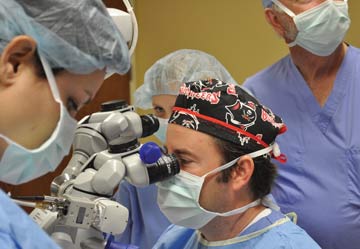Injections and sustained release formulations of intraocular steroids and a medication that helps maintain pupil dilation during surgery hold promise for helping surgeons perform better surgery and reducing the burden of drop regimens that prevent
post-op complications.
Omidria from Omeros, a phenylephrine and ketorolac irrigating solution administered through balanced salt solution during surgery, is FDA approved to maintain intraoperative pupillary dilation and is said to reduce post-op pain in patients. The
drug's pass-through status — CMS pays facilities about $500 per case for its use — has been extended through 2021. Although surgical facilities receive separate reimbursement for the costly but effective medication, some surgeons
still opt to use mechanical devices to manage miosis, especially in patients with floppy iris syndrome. For example, Dr. Chu often reaches for the XpandNT from Diamatrix, a device that holds pupils wide open to provide him with unimpeded access
to the anterior chamber. "It's available in single- and multi-use versions, giving facilities the ability to purchase the most cost-effective option," he says.
Dexycu, a dexamethasone suspension in a biodegradable sustained-release aqueous sphere, is placed in the posterior chamber at the end of surgery to prevent post-op inflammation. Surgeons also have the option to use the intracanalicular implant
Dextenza, which is inserted into the inferior punctum and remains in place for up to 30 days to deliver a tapering dose of dexamethasone.
Both drugs are FDA approved to prevent post-op inflammation and pain. The FDA's approval perhaps gives surgeons and patients more confidence in their use than compounded drop therapies available at a much lower cost. CMS reimburses facilities
for the use of Dexycu and Dextenza separate from the standard cataract surgery fee, but some surgeons can't justify billing Medicare hundreds of dollars per case in a high-volume specialty when less costly alternative medications are available.
Dr. Newsom understands the allure of using FDA-approved medications to maintain intraoperative mydriasis or prevent post-op complications, but believes their use should be limited and determined on a case-by-case basis. "For example, placing dexamethasone
into the eye at the end of surgery might make sense for Medicare patients who will have difficulty complying with a post-op drop regimen," he explains. "I'd feel more comfortable spending the money on patients who wouldn't administer the steroidal
drops that prevent serious complications."
For now, Dr. Chu is sticking with prescribing his patients post-op topical antibiotic and steroidal drops, or both medications in combination drops, partly because Dexycu and Dextenza only eliminate the need for the steroid topical treatment.
"If injections or plugs are developed that contain a nonsteroidal and an antibiotic, and they're shown to be effective, we might make the switch," says Dr. Chu.
Sublingual sedation is also a developing trend. MKO Melt from Imprimis is a tab containing midazolam, ketamine and ondansetron that's placed under a patient's tongue before their procedures. "It's been an invaluable tool in our clinic," says Dr.
Chu. For several years, Dr. Chu used the tablets in place of IV sedation, a move that satisfied patients, who he says sometimes fear the stick of the IV start more than the surgery itself. Over time, however, Dr. Chu found patient flow at
his busy surgery center was more conducive to the faster onset of IV sedation. (The MKO Melt, which is ingested though the digestive system, typically takes effect in 15 to 20 minutes, according to Dr. Chu.) "We've gone back to placing a small
hep-lock in patients to administer IV anesthetic, but the tablets are extremely helpful for calming patients who are overly anxious before surgery," says Dr. Chu. "They definitely still have a place in our practice in augmenting IV anesthesia."
.svg?sfvrsn=be606e78_3)


.svg?sfvrsn=56b2f850_5)